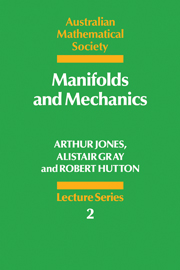Book contents
- Frontmatter
- Contents
- PROLOGUE
- 1 CALCULUS PRELIMINARIES
- 2 DIFFERENTIABLE MANIFOLDS
- 3 SUBMANIFOLDS
- 4 DIFFERENTIABILITY
- 5 TANGENT SPACES AND MAPS
- 6 TANGENT BUNDLES AS MANIFOLDS
- 7 PARTIAL DERIVATIVES
- 8 DERIVING LAGRANGE'S EQUATIONS
- 9 FORM OF LAGRANGE'S EQUATIONS
- 10 VECTORFIELDS
- 11 LAGRANGIAN VECTORFIELDS
- 12 FLOWS
- 13 THE SPHERICAL PENDULUM
- 14 RIGID BODIES
- REFERENCES
- INDEX
- SYMBOL TABLE
10 - VECTORFIELDS
Published online by Cambridge University Press: 28 January 2010
- Frontmatter
- Contents
- PROLOGUE
- 1 CALCULUS PRELIMINARIES
- 2 DIFFERENTIABLE MANIFOLDS
- 3 SUBMANIFOLDS
- 4 DIFFERENTIABILITY
- 5 TANGENT SPACES AND MAPS
- 6 TANGENT BUNDLES AS MANIFOLDS
- 7 PARTIAL DERIVATIVES
- 8 DERIVING LAGRANGE'S EQUATIONS
- 9 FORM OF LAGRANGE'S EQUATIONS
- 10 VECTORFIELDS
- 11 LAGRANGIAN VECTORFIELDS
- 12 FLOWS
- 13 THE SPHERICAL PENDULUM
- 14 RIGID BODIES
- REFERENCES
- INDEX
- SYMBOL TABLE
Summary
In modern terminology, the right-hand side of a differential equation determines a “vectorfield11”, which means assigning an “arrow” to each point of the domain, while the solutions of the differential equation are referred to as “integral curves”, which are tangential to the arrows. In the context of manifolds, the integral curves are regarded as maps into the manifold while the “arrows” are elements of its tangent spaces. The modern terminology thus invites us to think of differential equations in a very geometrical way. In this chapter, enough of the theory of vectorfields will be developed to enable Lagrange's and Newton's equations to be put into proper geometric and analytic perspective.
Among the most basic results in the theory of differential equations are those concerning the existence and uniqueness of solutions and these results translate easily into corresponding results about integral curves. When studying vectorfields and their integral curves on a manifold, however, it is important to distinguish between “local” and “global” propertiesj the former refer to what happens in a particular chart domain whereas the latter refer to what happens on the whole manifold.
Finally, some special properties of vectorfields which arise from second-order differential equations, such as Lagrange's equations, will be studied.
BASIC IDEAS
In this section we introduce the ideas of vectorfields and integral curves and give a vectorfield version of the classical existence and uniqueness theorem for the solutions of differential equations.
A vectorfield may be thought of as a mapping from a manifold M to its tangent space TM which preserves the base points. The formal definition is as follows.
- Type
- Chapter
- Information
- Manifolds and Mechanics , pp. 98 - 109Publisher: Cambridge University PressPrint publication year: 1987

